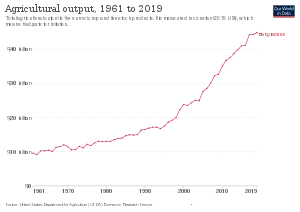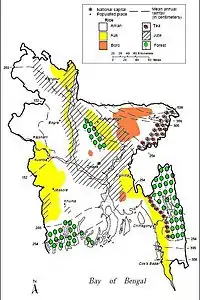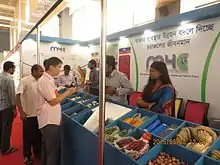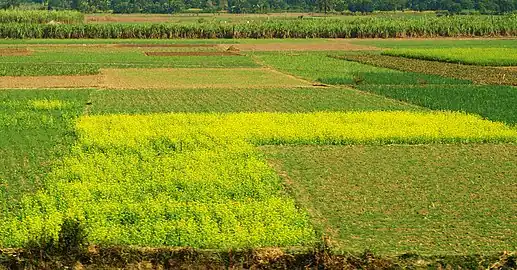Agriculture in Bangladesh
Agriculture is the largest employment sector in Bangladesh, making up 14.2 percent of Bangladesh's GDP in 2017 and employing about 42.7 percent of the workforce.[1] The performance of this sector has an overwhelming impact on major macroeconomic objectives like employment generation, poverty alleviation, human resources development, food security, and other economic and social forces. A plurality of Bangladeshis earn their living from agriculture. Due to a number of factors, Bangladesh's labour-intensive agriculture has achieved steady increases in food grain production despite the often unfavorable weather conditions.[2] These include better flood control and irrigation, a generally more efficient use of fertilisers, as well as the establishment of better distribution and rural credit networks.[2]


Although rice and jute are the primary crops, maize and vegetables are assuming greater importance.[2] Due to the expansion of irrigation networks, some wheat producers have switched to cultivation of maize which is used mostly as poultry feed.[2] Tea is grown in the northeast.[2] Because of Bangladesh's fertile soil and normally ample water supply, rice can be grown and harvested three times a year in many areas.[2] The country is among the top producers of rice (third), potatoes (seventh), tropical fruits (sixth), jute (second), and farmed fish (fifth).[3][4] With 35.8 million metric tons produced in 2000, rice is Bangladesh's principal crop. In comparison to rice, wheat output in 1999 was 1.9 million tonnes (1,900,000 long tons; 2,100,000 short tons).
Population pressure continues to place a severe burden on productive capacity, creating a food deficit, especially of wheat. Foreign assistance and commercial imports fill the gap. Underemployment remains a serious problem, and a growing concern for Bangladesh's agricultural sector will be its ability to absorb additional manpower.[2] Finding alternative sources of employment will continue to be a daunting problem for future governments, particularly with the increasing numbers of landless peasants who already account for about half the rural labour force.[2] Other challenges facing the sector include environmental issues: insecticides, water management challenges, pollution, and land degradation all effect the agricultural system in Bangladesh. Bangladesh is particularly vulnerable to climate change, with extreme weather and temperature changes significantly changing the conditions for growing food. Adaptation of the agricultural sector is a major concern for policy addressing climate change in Bangladesh.
Food crops

Although rice, wheat, mango and jute are the primary crops, rice and wheat are mostly main crops or food crops of some countries.[5] Due to the expansion of irrigation networks, some wheat producers have switched to cultivation of maize which is used mostly as poultry feed.[5] Tea is grown in the northeast.[5] Because of Bangladesh's fertile soil and normally ample water supply, rice can be grown and harvested three times a year in many areas.[5] Due to a number of factors, Bangladesh's labour-intensive agriculture has achieved steady increases in food grain production despite the often unfavorable weather conditions.[5] These include better flood control and irrigation, a generally more efficient use of fertilizers, and the establishment of better distribution and rural credit networks.[5] With 28.8 million metric tons produced in 2005–2006 (July–June), rice is Bangladesh's principal crop.[5] By comparison, wheat output in 2005–2006 was 9 million metric tons.[5] Population pressure continues to place a severe burden on productive capacity, creating a food deficit, especially of wheat.[5] Foreign assistance and commercial imports fill the gap.[5] Underemployment remains a serious problem, and a growing concern for Bangladesh's agricultural sector will be its ability to absorb additional manpower.[5]
Food grains are cultivated primarily for subsistence. Only a small percentage of total production makes its way into commercial channels. Other Bangladeshi food crops, however, are grown chiefly for the domestic market. They include potatoes and sweet potatoes, with a combined record production of 1.9 million tons in FY 1984; oilseeds, with an annual average production of 250,000 tons; and fruits such as bananas, jackfruit, mangoes, and pineapples. Estimates of sugarcane production put annual production at more than 7 million tons per year, most of it processed into a coarse, unrefined sugar known as gur, and sold domestically.
Rice

Bangladesh is the fourth largest rice[6] producing country in the world. National sales of the classes of insecticide used on rice, including granular carbofuran, synthetic pyrethroids, and malathion exceeded 13,000 tons of formulated product in 2003.[7][8] The insecticides not only represent an environmental threat, but are a significant expenditure to poor rice farmers. The Bangladesh Rice Research Institute is working with various NGOs and international organisations to reduce insecticide use in rice.[9]
Wheat
Wheat is not a traditional crop in Bangladesh, and in the late 1980s little was consumed in rural areas. During the 1960s and early 1970s, however, it was the only commodity for which local consumption increased because external food aid was most often provided in the form of wheat. In the first half of the 1980s, domestic wheat production rose to more than 1 million tons per year but was still only 7 to 9 percent of total food grain production. Record production of nearly 1.5 million tons was achieved in FY 1985, but the following year saw a decrease to just over 1 million tons. About half the wheat is grown on irrigated land. The proportion of land devoted to wheat remained essentially unchanged between 1980 and 1986, at a little less than 6 percent of total planted area.
Wheat also accounts for the great bulk of imported food grains, exceeding 1 million tons annually and going higher than 1.8 million tons in FY 1984, FY 1985, and FY 1987. The great bulk of the imported wheat is financed under aid programs of the United States, the European Economic Community.
Animal agriculture
Poultry
Poultry farming in Bangladesh is the process of keeping various types of birds for meat, egg, feather, or sale. In Bangladesh, poultry birds are primarily used for meat and egg consumption.
The weather in Bangladesh is perfect for raising poultry, with several types of poultry birds having been domesticated for many years. As of 2017, about 300 billion taka was invested in the poultry industry, with an estimated 150,000 poultry farms in Bangladesh.[10] From 2 to 4 March 2017, Poultry Science Association Bangladeshi branch held the tenth International Poultry Show and Seminar in Bashundhara Convention centre, Dhaka, Bangladesh.[11] By 2019, significant further investments were noted in the sector. The farms produce 570 million tonnes of meat and 7.34 billion eggs annually.[12] Poultry feed is primarily made from imported soybean and soy meal.[13] The per capita consumption of meat and egg in Bangladesh remains below the level recommended by the Food and Agriculture Organization.[14] The impact of Avian Influenza in 2007 and the COVID-19 pandemic has been detrimental to the poultry and associated feed industry in Bangladesh. The outbreak in 2007 resulted in the closure of two-thirds of all farms in Bangladesh. In March 2023, poultry farmers urged the government to set chicken and egg prices for the local market, highlighting the industry's significance in the country's economy[15] Notable figures in the poultry sector include Late Syed Hedayetullah and Phanindra Nath Saha, who developed the poultry sector with Aftab Bahumukhi Farms.[16]Shrimp
As of the end of 1987, prevailing methods for culturing shrimp in Bangladesh were still relatively unsophisticated, and average yields per hectare were low.[17] In the late 1980s, almost all inland shrimping was done by capture rather than by intensive aquaculture.[17] Farmers relied primarily on wild postlarval and juvenile shrimp as their sources of stock, acquired either by trapping in ponds during tidal water exchange or by gathering from local estuaries and stocking directly in the ponds.[17] Despite the seemingly low level of technology applied to shrimp aquaculture, it became an increasingly important part of the frozen seafood industry in the mid-1980s.[17] The shrimp farming industry in Bangladesh has been handicapped by low-quality and low prices.
The World Bank and the Asian Development Bank financed projects to develop shrimp aquaculture in the 1980s.[17] Much of the emphasis was on construction of modern hatcheries.[17] Private investors were also initiating similar projects to increase capacity and to introduce modern technology that would increase average yields.[17] The Food and Agriculture Organization of the United Nations (FAO) has provided assistance to the shrimp and fishing industry in meeting fish safety and quality control standards based on the Hazard Analysis Critical Control Point (HACCP) approach.[18]
Shrimp in the wild are associated with mangrove. Mangrove estuaries such as those found in the Sundarbans of southwestern Bangladesh are especially rich productive ecosystems and provide the spawning grounds for shrimp and fish.[19] Intensive shrimp farming often involves conversion of mangrove stands to brine ponds where shrimp are grown.[20]Commodity crops
Tea

Bangladesh is an important tea-producing country. It is the 12th[21] largest tea producer in the world. Its tea industry dates back to British rule, when the East India Company initiated the tea trade in the hills of the Sylhet region.[22] In addition to that, tea cultivation was introduced to Greater Chittagong in 1840.[23] Today, the country has 166 commercial tea estates, including many of the world's largest working plantations.[24][25] The industry accounts for 3% of global tea production, and employs more than 4 million people.[26]
The tea is grown in the northern and eastern districts, the highlands, temperate climate, humidity and heavy rainfall within these districts provide a favourable ground for the production of high quality tea.[26]Edible Oil
Mustard oil production in Bangladesh rose by 3.35 lakh tones to 11.52 lakh tones this year, according to the agriculture ministry. Mustard oil output worth Tk 3,000 crore in Bangladesh.[27]
Environmental issues
Insecticides
National sales of the classes of insecticide used on rice, including granular carbofuran, synthetic pyrethroids, and malathion exceeded 13,000 tons of formulated product in 2003.[28] Insecticides not only represent an environmental threat, but are a significant expenditure to poor rice farmers. The Bangladesh Rice Research Institute is working with various NGOs and international organisations to reduce insecticide use in rice.[29]
Climate change
In most countries like Bangladesh, yields from rain-fed agriculture was predicted to be reduced to 50% by 2020. For a country with increasing population and hunger, this will have an adverse effect on food security. Although the effects of climate change are highly variable, by 2030, South Asia could lose 10% of rice and maize yields, while neighboring states like Pakistan could experience a 50% reduction in crop yield.
As a result of all this, Bangladesh would need to prepare for long-term adaptation, which could be as drastic as changing sowing dates due to seasonal variations, introducing different varieties and species, to practicing novel water supply and irrigation systems.[30]: 230 Bangladeshi farmers have been adapting to rising water levels by making creative floating gardens which mesh water hyacinth plants with bamboo and fertilizer to provide a sturdy floating platform for agriculture, according to climate researcher Alizé Carrère.[31]
Being an agrarian society, people of Bangladesh are greatly dependent on various forms of agriculture. It is the main source of rural job in the country having over 87% people somewhat related to agri-based economy.[32] In 2016, according to World Bank, agriculture contributed to 14.77% of country's GDP. A steady increase in agricultural production with the use of modern equipment and scientific methods, agriculture has been a key driver to eradicate rural poverty in Bangladesh. The risk of sea level rising and global warming is the biggest challenge not only to country's agricultural improvement but also the success on poverty reduction.

As agricultural production is heavily related with temperature and rainfall, the current change in weather conditions is creating negative impact on crop yielding and the total area of arable land has been decreased. According to a report published by the Ministry of Environment and Forests - GoB, 1 degree Celsius increase in maximum temperature at vegetative, reproductive and ripening stages there was a decrease in Aman rice production by 2.94, 53.06 and 17.28 tons respectively.[33] Another major threat deriving from this factor is water salinity which directly affects rice production especially in the coastal part of Bangladesh. The same report state that, the country will lose 12-16% of its land if the sea level rises by 1 meter. These challenges lead to food scarcity and insecurity for the huge populace of the country. There are several adaptation measures which are practised to cope up with the abnormal behaviour of climate such as: resilient varieties of crops, diversification, change in cropping pattern, mixed cropping, improved irrigation facility, adopting soil conservation, agroforestry and so on.[34]
A number of these measures have already been adapted by the government of Bangladesh and well practised throughout the country. The Bangladesh Rice Research Institute has introduced a varieties of saline tolerant rices like BR-11, BR-23, BRRI rice -28, BRRI rice -41, BRRI rice -47, BRRI rice -53 and BRRI rice -54. In the drought prone areas, BR-11, BR-23, BRRI rice -28, BRRI rice -41, BRRI rice -47, BRRI rice -53 and BRRI rice -54 are used which take short time to cultivate. To make the best and efficient utilization of water the Department of Agricultural Extension has introduced 'Alternate Wetting and Drying (AWD).[33] The government also provide financial support to the affected farmers from different disasters and hazardsGovernment
Ministry of Agriculture
See also
References
- "CIA – The World Factbook". Central Intelligence Agency. Retrieved 5 December 2019.
- "Background Note: Bangladesh". Bureau of South and Central Asian Affairs. March 2008. Retrieved 11 June 2008. This article incorporates text from this source, which is in the public domain.
- "Countries by Commodity". FAOSTAT. Food and Agriculture Organization of the United Nations. 2013. Archived from the original on 13 November 2016. Retrieved 13 November 2016.
- Golub, Stephen; Varma, Abir (February 2014). Fishing Exports and Economic Development of Least Developed Countries: Bangladesh, Cambodia, Comoros, Sierra Leone and Uganda (PDF) (Report). Swarthmore College. p. 23. Archived (PDF) from the original on 24 October 2014. Retrieved 17 February 2015.
- "Background Note: Bangladesh". Bureau of South and Central Asian Affairs (March 2008). Accessed 11 June 2008. This article incorporates text from this source, which is in the public domain.
- "IRRI – International Rice Research Institute" Archived 21 May 2008 at the Wayback Machine
- "Livelihoods and environment (Riches)". Archived from the original on 28 September 2007.
- "Bangladesh Business Figures". Archived from the original on 20 April 2020.
- "Rice IRRI" (PDF). Archived from the original (PDF) on 16 February 2008.
- "Poultry operators eye global market". The Daily Star. 5 March 2017. Retrieved 26 March 2017.
- "Poultry Industry Expo Gets Underway in Bangladesh". The Poultry Site. Retrieved 26 March 2017.
- "Tk 30,000cr needed to beef up poultry sector". The Daily Star. 3 March 2017. Retrieved 26 March 2017.
- "Import of soymeal, key feed ingredient, on the decline". The Daily Star. 26 March 2017. Retrieved 26 March 2017.
- "Poultry operators plan to raise investment". The Daily Star. 29 January 2015. Retrieved 26 March 2017.
- "Poultry farmers urge govt to fix egg, chicken prices". The Daily Star. 6 March 2023. Retrieved 2 September 2023.
- "Poultry industry still reeling from bird flu". IRIN. 9 August 2012. Retrieved 26 March 2017.
- Heitzman, James; Worden, Robert L, eds. (1989). "Fisheries". Bangladesh: a country study. Washington, D.C.: Federal Research Division, Library of Congress. pp. 128–129. OCLC 49223313.
 This article incorporates text from this source, which is in the public domain.
This article incorporates text from this source, which is in the public domain. - Cato, James C.; Subasinge, S. (September 2003). Unnevehr, Laurian J. (ed.). "Case Study: The Shrimp Export Industry in Bangladesh" (PDF). Food Safety in Food Security and Food Trade. 2020 Vision Focus. Washington, DC: International Food Policy Research Institute. Retrieved 27 April 2012.
- de la Torre, Isabel; Batker, D.K. (1999). "Prawn to Trade, Prawn to Consume" (PDF). International Shrimp Action Network. pp. 9–10. Archived from the original (PDF) on 3 November 2005. Retrieved 20 August 2007.
- Harrison, Paul; Pearce, Fred (2000). "Mangroves and estuaries" (PDF). AAAS Atlas of Population and Environment. American Association for the Advancement of Science and University of California Press. p. 139. ISBN 978-0-520-23081-1.
- Chen, Alice. "The World's Top Tea-Producing Countries". World Atlas. Retrieved 19 March 2023.
- "Tea Industry". Banglapedia: National Encyclopedia of Bangladesh. Asiatic Society of Bangladesh.
- চা শিল্পের ইতিহাস. teaboard.gov.bd (in Bengali). Retrieved 3 April 2015.
- Dr. Kazi Muzafar Ahammed. "Investment for Sustainable Development of Bangladesh Tea Industry – An Empirical Study" (PDF). Bangladesh Economic Association. Retrieved 3 April 2015.
- "Tea Gardens in Bangladesh". bangladesh.com. Retrieved 24 March 2015.
- Mansur, Muhammed Alee (September 2006). "Bangladeshi Tea in the International Market" - Problems and Prospects (MBA). Southern University. Retrieved 24 March 2015 – via Scribd.
- "Mustard output worth Tk 3,000 crore in Bangladesh". The Daily Star. 2 May 2023. Retrieved 2 May 2023.
- Riches, Charle. "Enhancing Rural Livelihoods Need Not Cost the Earth". Petrra-irri.org. Archived from the original on 28 September 2007.
- Barclay, Adam (October–December 2004). "Reason to Cheer" (PDF). Rice Today. Vol. 3, no. 4. Archived from the original (PDF) on 16 February 2008. Retrieved 27 January 2008.
- Sunny, Sanwar (2011). Green Buildings, Clean Transport and the Low Carbon Economy. Lambert Academic Publishing GmbH KG. ISBN 978-3-8465-9333-2.
- Alizé Carrère, PBS, September 2021, ADAPTATION: Floating Gardens of Bangladesh, retrieved September 25, 2021, "...farmers start with water hyacinth, a tightly-knit water weave that floats, piling layers of it together to be crushed down into a compact bed that floats..."
- "Agriculture Growth Reduces Poverty in Bangladesh". World Bank. Retrieved 11 July 2018.
- "International Union for Conservation of Nature - IUCN". IUCN. Retrieved 11 July 2018.
- Akinnagbe, Oluwole; Irohibe, Ifeoma (9 February 2015). "Agricultural adaptation strategies to climate change impacts in Africa: a review". Bangladesh Journal of Agricultural Research. 39 (3): 407–418. doi:10.3329/bjar.v39i3.21984.
- "Ministry of Agriculture". moa.gov.bd.
![]() This article incorporates text from this source, which is in the public domain. Country Studies. Federal Research Division.
This article incorporates text from this source, which is in the public domain. Country Studies. Federal Research Division.